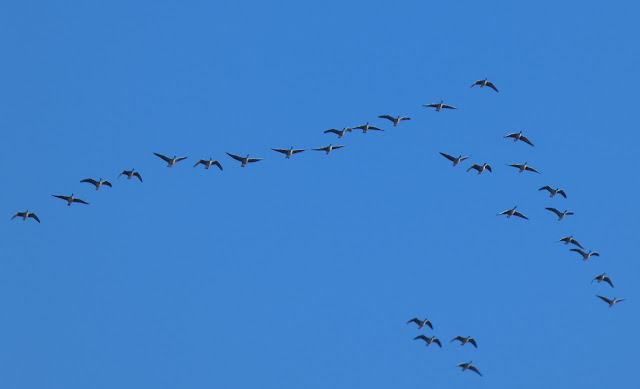Our second full day in Norfolk began with
another pre-breakfast seawatch from Hunstanton seafront, this time John joined
me. It was mostly the same species as yesterday with just the addition of three
Red-breasted Mergansers. After breakast we took the coastal bus the short
distance to Titchwell.
We had planned to check the feeders behind the centre
where we had Brambling last year but for some reason the feeding station had
been taken down. Instead we walked along the Fen Trail to where the Woodcocks
were roosting. Although we'd been told they'd moved out of sight there was
still a number of people looking anyway so we joined them. I managed to pick up
the top half of one quite far back under the trees but it was through such a
narrow window that I couldn't get anyone else on it. Another one was claimed
and I could see some feathers, however when I got the scope on it I could see
it was just the wing of an unidentifiable corpse.
We carried on to the main path and slowly
made our way up to the beach, stopping regularly to scan. A pair of Bearded
Tits popped up in front of us then quickly flew off. Out on the freshwater
lagoon it was wader central: the close island was a shimmering sparkle of 1,800
Golden Plover with hundreds of Lapwing on every island.
 |
| Golden Plover & Lapwing |
In the middle was a
flock of 45 Avocets and there were a few Dunlin as well. At the next marsh were
a dozen Knot, and both Black-tailed and Bar-tailed Godwits.
 |
| Knot |
 |
| Bar-tailed Godwit |
 |
| Common Redshank |
At the beach we saw more waders with Grey
and Ringed Plovers and a few Sanderling scampering around chasing or being
chased by the waves. The sea was a lot quieter than it had been at Holkham the
day before but we did get a flock of five Long-tailed Ducks but surprisingly no
Red-throated Divers.
While walking back a Short-eared Owl
started flying around over the saltmarsh. This is one of my favourite birds so
it was great to watch it out hunting in the middle of the day. We had lunch in
the hide watching more of the same waders until a Sparrowhawk flew over
flushing them all. We'd heard a Bittern had been showing well at the last pool
earlier so we thought we'd look for it even though we didn't expect it to still
be around. However there was quite a large group of people stood on the path
and the Bittern was still on show, well sort of. It was feeding just inside the
reedbed so bits of it could be seen. Every now and again it walked past a gap
in the reeds and if you were in the right place you could see the whole bird.
 |
| Bittern |
 |
| Bittern |
After eventually getting some good views we went back to the centre for a hot
drink. We tried for the Woodcock again but didn't see it so decided to walk
back along the main path towards the Bittern. It was still in the same place
and we had slightly better views than earlier. Flocks of both Brent Geese and Pink-footed Geese flew over calling - one of the joys of birding in winter on the North Norfolk coast.
 |
| Brent Geese |
 |
| Pink-footed Geese |
Marsh Harriers were beginning to
come into roost and as we'd had a good day we headed off to get the bus back to
Hunstanton. Today's day list was 80 species, two more than yesterday and it'd
been another great day with glorious weather. We just got back in daylight and I managed to get a photo of the sun setting over the sea - one of the few
places this is possible on the eastern side of England.
 |
| Setting sun |
The following morning we spent an hour on the seafront but didn't see anything new - we left that for the journey home when we added Green Woodpecker from the bus and Stock Dove from the train giving a total species count of 103 for our winter's break in Norfolk.





No comments:
Post a Comment